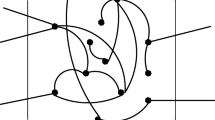Abstract
We introduce the method of proving complexity dichotomy theorems by holographic reductions. Combined with interpolation, we present a unified strategy to prove #P-hardness. Specifically, we prove a complexity dichotomy theorem for a class of counting problems on 2–3 regular graphs expressible by Boolean signatures. For these problems, whenever a holographic reduction followed by interpolation fails to prove #P-hardness, we can show that the problem is solvable in polynomial time.
Similar content being viewed by others
References
Andrei A. Bulatov (2008). The Complexity of the Counting Constraint Satisfaction Problem. In ICALP (1), Luca Aceto, Ivan Damgård, Leslie Ann Goldberg, Magnús M. Halldórsson, Anna Ingólfsdóttir & Igor Walukiewicz, editors, volume 5125 of Lecture Notes in Computer Science, 646–661. Springer. ISBN 978-3-540-70574-1.
Bulatov Andrei A., Victor Dalmau (2007) Towards a dichotomy theorem for the counting constraint satisfaction problem. Information and Computation 205(5): 651–678
Bulatov Andrei A., Martin Grohe (2005) The complexity of partition functions. Theor. Comput. Sci. 348(2-3): 148–186
Jin-Yi Cai, Xi Chen & Pinyan Lu (2011a). Non-negatively Weighted #CSP: An Effective Complexity Dichotomy. In IEEE Conference on Computational Complexity, 45–54. IEEE Computer Society.
Cai Jin-Yi, Vinay Choudhary (2007) Valiant’s Holant Theorem and matchgate tensors. Theor. Comput. Sci. 384(1): 22–32
Jin-Yi Cai, Sangxia Huang & Pinyan Lu (2010a). From Holant to #CSP and Back: Dichotomy for Holantc Problems. In ISAAC (1), Otfried Cheong, Kyung-Yong Chwa & Kunsoo Park, editors, volume 6506 of Lecture Notes in Computer Science, 253–265. Springer. ISBN 978-3-642-17516-9.
Jin-Yi Cai & Michael Kowalczyk (2010). A Dichotomy for k-Regular Graphs with {0, 1}-Vertex Assignments and Real Edge Functions. In TAMC, Jan Kratochvíl, Angsheng Li, Jirí Fiala & Petr Kolman, editors, volume 6108 of Lecture Notes in Computer Science, 328–339. Springer. ISBN 978-3-642-13561-3.
Jin-Yi Cai & Michael Kowalczyk (2012). Spin systems on k-regular graphs with complex edge functions. Theoretical Computer Science.
Cai Jin-Yi, Pinyan Lu (2010) On Symmetric Signatures in Holographic Algorithms. Theory Comput. Syst. 46(3): 398–415
Cai Jin-Yi, Pinyan Lu (2011) Holographic algorithms: From art to science. J. Comput. Syst. Sci. 77(1): 41–61
Jin-Yi Cai, Pinyan Lu & Mingji Xia (2008). Holographic Algorithms by Fibonacci Gates and Holographic Reductions for Hardness. In FOCS ’08: Proceedings of the 49th Annual IEEE Symposium on Foundations of Computer Science. IEEE Computer Society, Washington, DC, USA.
Jin-Yi Cai, Pinyan Lu & Mingji Xia (2009). Holant problems and counting CSP. In STOC, Michael Mitzenmacher, editor, 715–724. ACM. ISBN 978-1-60558-506-2.
Jin-Yi Cai, Pinyan Lu & Mingji Xia (2010b). Holographic Algorithms with Matchgates Capture Precisely Tractable Planar #CSP. In FOCS, 427–436. IEEE Computer Society. ISBN 978-0-7695-4244-7.
Cai Jin-Yi, Pinyan Lu, Xia Mingji (2011) Computational Complexity of Holant Problems. SIAM J. Comput. 40(4): 1101–1132
Cai Jin-Yi, Pinyan Lu, Xia Mingji (2011) A computational proof of complexity of some restricted counting problems. Theor. Comput. Sci. 412(23): 2468–2485
Jin-Yi Cai, Pinyan Lu & Mingji Xia (2011d). Holographic algorithms by Fibonacci gates. Linear Algebra and its Applications.
Dagum Paul, Michael Luby (1992) Approximating the permanent of graphs with large factors. Theor. Comput. Sci. 102: 283–305
Dodson Christopher T.J., Timothy Poston (1991) Tensor Geometry. Graduate Texts in Mathematics 130. Springer-Verlag, New York
Martin E. Dyer, Leslie Ann Goldberg & Mike Paterson (2007). On counting homomorphisms to directed acyclic graphs. J. ACM 54(6).
Dyer Martin E., Greenhill Catherine S. (2000) The complexity of counting graph homomorphisms. Random Struct. Algorithms 17(3-4): 260–289
Martin E. Dyer & David Richerby (2010). On the complexity of #CSP. In Proceedings of the 42nd ACM symposium on Theory of computing, 725–734.
Greenhill Catherine S. (2000) The complexity of counting colourings and independent sets in sparse graphs and hypergraphs. Computational Complexity 9(1): 52–72
Jerrum Mark (1987) Two-dimensional monomer-dimer systems are computationally intractable. Journal of Statistical Physics 48: 121–134
Kasteleyn P.W. (1961) The statistics of dimers on a lattice. Physica 27: 1209–1225
Michael Kowalczyk & Jin-Yi Cai (2010). Holant Problems for Regular Graphs with Complex Edge Functions. In STACS, Jean-Yves Marion & Thomas Schwentick, editors, volume 5 of LIPIcs, 525–536. Schloss Dagstuhl - Leibniz-Zentrum fuer Informatik. ISBN 978-3-939897-16-3.
H. N. V. Temperley & M. E. Fisher (1961). Dimer problem in statistical mechanics C an Exact Result. Philosophical Magazine 6, 1061C 1063.
Vadhan Salil P. (2001) The Complexity of Counting in Sparse, Regular, and Planar Graphs. SIAM J. Comput. 31(2): 398–427
Valiant Leslie G. (1979) The Complexity of Computing the Permanent. Theor. Comput. Sci. 8: 189–201
Valiant Leslie G. (1979) The Complexity of Enumeration and Reliability Problems. SIAM J. Comput. 8(3): 410–421
Leslie G. Valiant (2006). Accidental Algorithms. In FOCS ’06: Proceedings of the 47th Annual IEEE Symposium on Foundations of Computer Science, 509–517. IEEE Computer Society, Washington, DC, USA.
Valiant LeslieG. (2008) Holographic Algorithms. SIAM J. Comput. 37(5): 1565–1594
Xia Mingji, Peng Zhang, Zhao Wenbo (2007) Computational complexity of counting problems on 3-regular planar graphs. Theor. Comput. Sci. 384(1): 111–125
Author information
Authors and Affiliations
Corresponding author
Rights and permissions
About this article
Cite this article
Cai, JY., Lu, P. & Xia, M. Holographic reduction, interpolation and hardness. comput. complex. 21, 573–604 (2012). https://doi.org/10.1007/s00037-012-0044-6
Received:
Published:
Issue Date:
DOI: https://doi.org/10.1007/s00037-012-0044-6



